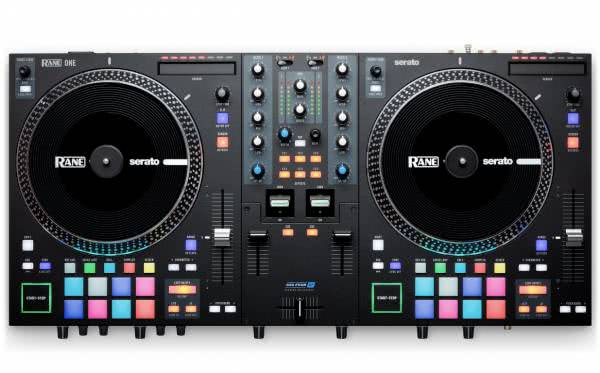Rane launched its first controller, the Rane One, in early 2021. For years, Rane held a unique position in the world of DJ gear, having developed the first digital turntable, the Rane Twelve, and the Rane Seventy Two - a benchmark for battle mixers. Rane has also found its place in the DJ booth for artists such as Jazzy Jeff, DJ Craze, JFB, DJ Skillz, Statik, A-Trak and many others, so it was to be expected that the first controller would follow a similar style.
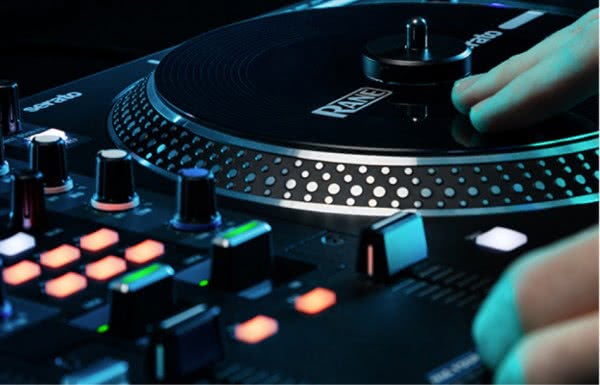 The Rane One effectively combines digital turntables with a battle mixer into a more compact form. Playback will not work in standalone mode, but will instead with the familiar Serato setup.
The Rane One effectively combines digital turntables with a battle mixer into a more compact form. Playback will not work in standalone mode, but will instead with the familiar Serato setup.
The biggest trade-offs compared to a Twelve + Seventy Two setup are the smaller platters (7.2" instead of 12") and the display on the mixer section that shows the waveform. Before we get too upset about that, let's not forget that the Rane One is half the price of a full Twelve + Seventy Two setup, and the compact size does come with some trade-offs. In terms of quality, however, no compromise has been made, with a robust metal build, the motorized direct-drive platters feel similar to a Technics 1200. The control platters are also of excellent quality, giving the real vinyl feel.
Another compromise to the compact design is that some knobs did not fit on the mixer section. These are all lined up on the front of the controller, where they are a little more awkward to use. Generally, we can accept that, but using the CUE controls is a bit uncomfortable at first. After a few hours of use, however, we intuitively knew where to reach. Also up front are the mic level controls and EQ, the Deck Control Adjust, and the Crossfader Contour Adjust.

The 2x8 Hot Cue/Sampler knobs have been moved to the Deck section, along with the corresponding function buttons: Hot Cue / Saved Loop / Roll / Sampler / Slicer.
3 of these buttons have a secondary function that can be activated by pressing them again:
Hot Cue secondary function: Pitch Play
Roll secondary function: Auto Loop
Sampler secondary function: Scratch Bank - this basically allows you to load 8 separate tracks onto the Performance Pads at the starting points you specify. These can be used for instant scratching.
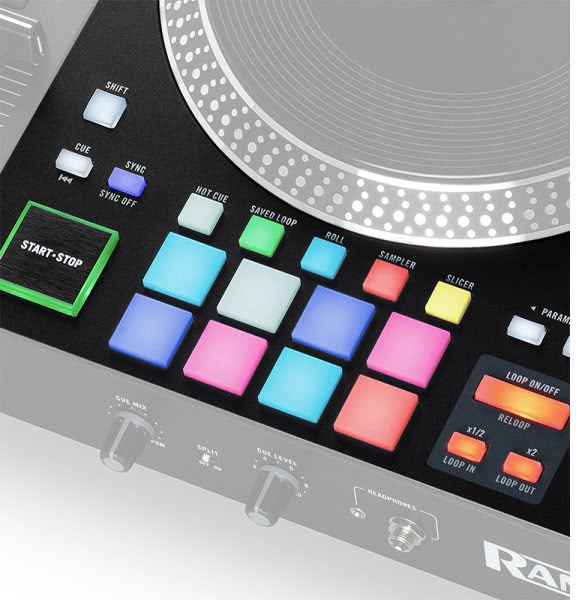 The Start/Stop button is exactly like the one on the Rane Twelve, and above it we have a discrete CUE button for those who don't want to mix in traditional vinyl mode but rather CDJ style, and right next to it we find a SYNC button for aligning the tempo of the tracks.
The Start/Stop button is exactly like the one on the Rane Twelve, and above it we have a discrete CUE button for those who don't want to mix in traditional vinyl mode but rather CDJ style, and right next to it we find a SYNC button for aligning the tempo of the tracks.
LOOP MODE has a prominent place, which we really appreciated, the big wide button is very handy, so it's easy to activate/duplicate loops.
The Pitch Bend section follows more of a traditional layout than the battle style of the Twelve, with the Pitch Fader positioned vertically, and also for those who prefer a CDJ-style mix, there's a +/- Pitch Bend button to momentarily speed up/slow down the tempo, just like when you nudge a jog wheel. The Pitch Fader can be moved precisely, just like on a regular turntable. To make it even more traditional, we have a click at 0%, just like on older Technics 1200/1210 players.
We might have preferred a separate Tempo Reset button, because you have to push quite a bit from the centre to change the tempo. It can be somewhat inconvenient when you want to beatmatch by ear around this area. The Pitch Range can be set between ±8%, ±16% and ±50%. The same button, together with Shift, activates KEYLOCK in order to maintain the same musical key on higher / lower pitch levels.
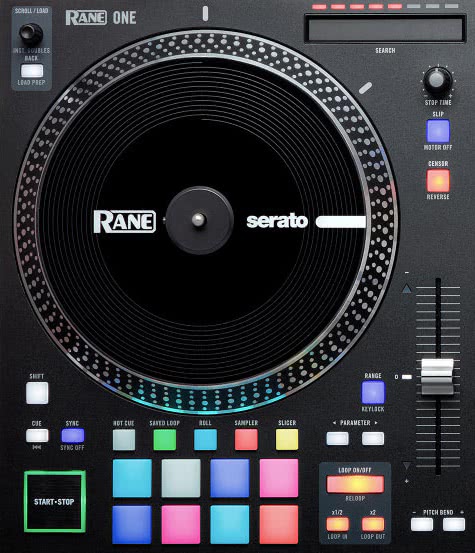 Also on the deck section, we have a generous Touch Strip, which allows you to quickly jump anywhere in the selected track. A handy feature, but perhaps this space could have been used better (maybe for a smaller display) and the same function could have been made Pioneer style, with pressing a button + spinning the platter.
Also on the deck section, we have a generous Touch Strip, which allows you to quickly jump anywhere in the selected track. A handy feature, but perhaps this space could have been used better (maybe for a smaller display) and the same function could have been made Pioneer style, with pressing a button + spinning the platter.
In addition to these, of course, there is the indispensable STOP TIME button, which controls how fast the platter stops after the STOP button is pressed. One button is shared between SLIP MODE and MOTOR OFF, which doesn't affect playback because everything is digital. Also the SHIFT button is used to switch the CENSOR / REVERSE functions of the button below it. CENSOR is essentially the same as REVERSE, it plays the track backwards, but after you deactivate, it jumps back to the same position from where you started rewinding from, so rewinding is basically just an effect that is inserted during playback, it doesn’t physically rewind the track.
There's also a BROWSE knob, which is standard on controllers, to browse your library without using the laptop, and a BACK/LOAD PREP button underneath: with BACK you can jump back to the previous Serato window (e.g. jump back from a folder), and with LOAD PREP (activated with SHIFT) you can select the track in the Prepare Crate.
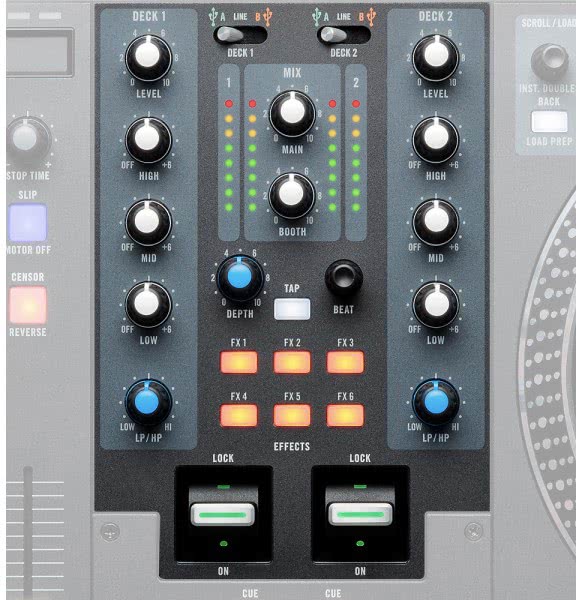 The mixer section is clean and intuitive, with the most important functions. The Volume Faders, Crossfader, and knobs are of very high quality as expected from Rane.
The mixer section is clean and intuitive, with the most important functions. The Volume Faders, Crossfader, and knobs are of very high quality as expected from Rane.
There's a 3-band EQ, plus a Filter Knob per Deck, which when turned to the left activates the Low Pass Filter and to the right the High Pass Filter.
The DEPTH knob, when turned, adjusts the wet-dry ratio of the built-in Flex FX.
Right between the filters, we have 6 very handy FX knobs that you can assign effects to within Serato. By holding them down, you can activate multiple effects at once. The beat button above them allows you to set the time division for the FX. The Lock Switch below them can be used to activate/deactivate effects. When you pull it towards yourself, it activates temporarily and when you release it, it deactivates. If you push it up, it stays active until you pull it back.
It is important to mention that the mixing section is standalone, so you can also connect external devices (turntable/digital player). If you want to connect a turntable, you won't be disappointed with the built-in Phono Preamps, and you can also use external turntables in DVS mode. Whatever mode you use the mixer in, the fat and punchy signature Rane sound will never disappoint.

Both the MAIN and BOOTH outputs have XLR connectors. There are also 2 separate USB ports for connecting two laptops and to do smooth B2B sessions.
By conclusion, the Rane One does not disappoint, its only rival at the moment is the Pioneer DDJ REV7.
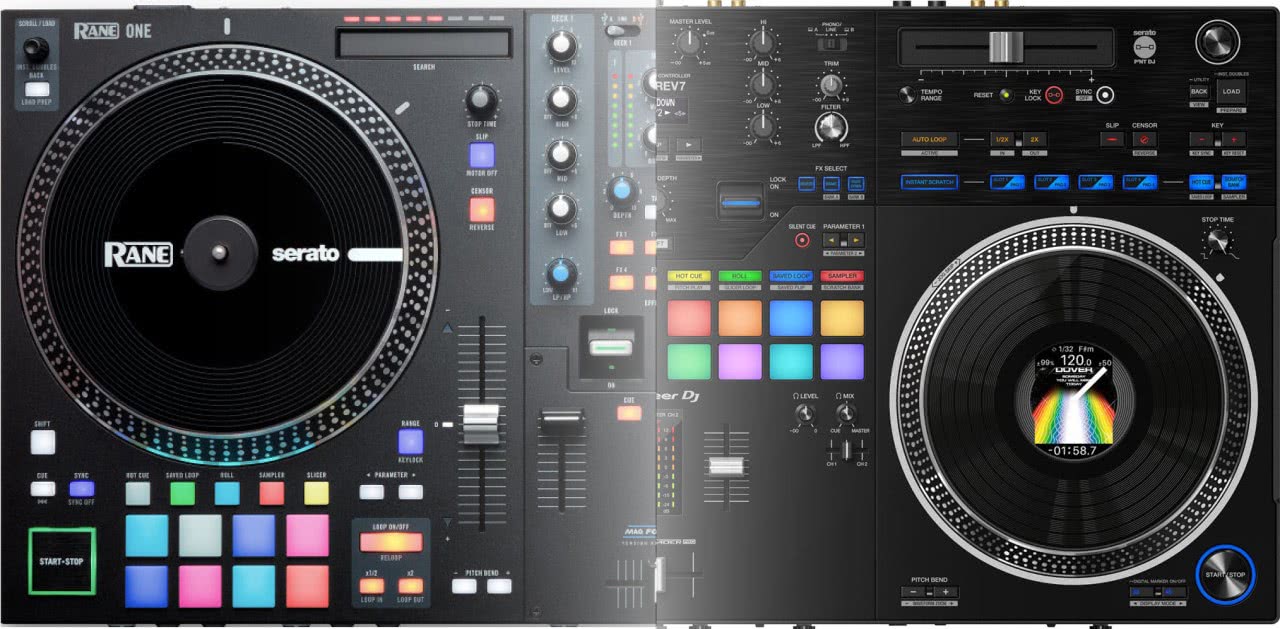
Some may miss two more channels and larger platters, but it is totally acceptable that Rane has opted for simplicity and portability.
From any perspective, they have probably found best possible middle ground between classic and current technology. For an upper mid-range price, they bring us the best of the functionality of a battle mixer and a motorized platter controller, which is quite a fantastic deal. The 7.2" control vinyls are easy to get used to, and after a few hours of practice, you can completely get the feel of it. It has an extremely professional feel and look, and will stand up to any club setup, so we expect it to be a serious option for DJs who prefer the battle style mixing.

